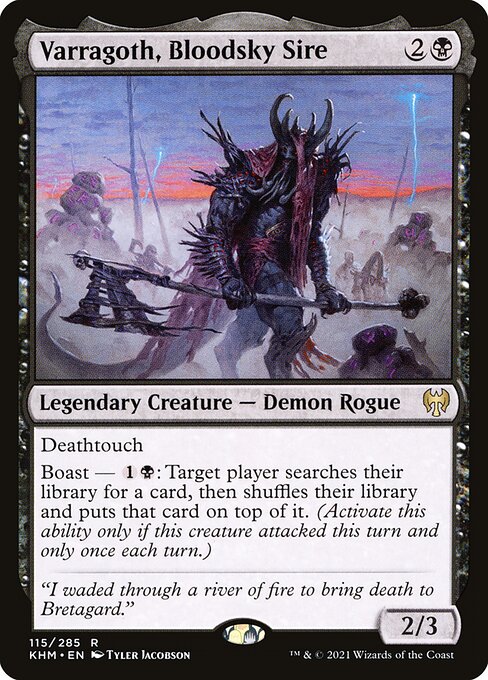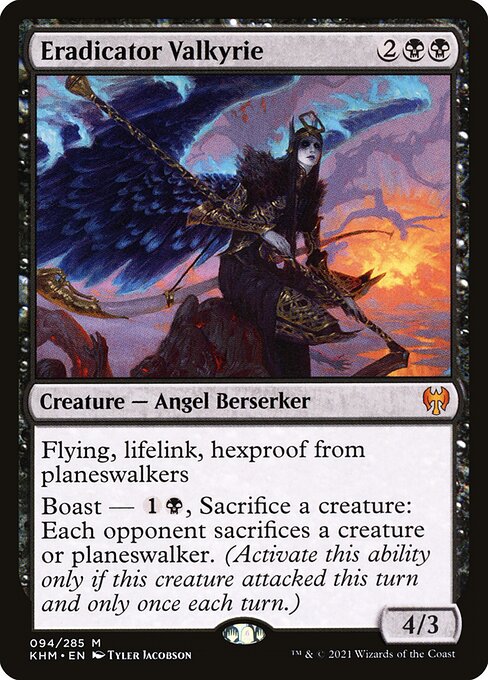It’s January of a new year, I’ve seen snow on the ground for the first time in six years, and we’re heading to Kaldheim, a Norse-inspired snowscape. I expected Berserkers and Valkyries and allusions to the Norse epics, but the one thing I didn’t anticipate was a mechanic based around flyting, or the poetic boasting battles between warriors. Etymologically, it comes from an Old English word meaning “to quarrel,” but there’s a more serious connotation to flyting in societies that are based around martial concepts of honor.
Flyting is a common trope in Norse epics, including in the Poetic Edda, where Loki goes off on the gods—dragging Odin for dressing in drag, shaming Frigg for supposedly sleeping with Odin’s brothers, and sneering at Skaldi for sleeping with him. (You gotta laugh at a god who sleeps with you then mocks you for it!) Flyting also shows up in Beowulf, when the eponymous hero faces off with the drunken Unferth before Grendel raids Heorot. Unferth calls out Beowulf for losing a rowing contest; Beowulf responds by claiming he may have lost that contest, but a) he ended up killing way more sea monsters in his journey and b) Unferth is one to talk, since he murdered his own brothers in combat. Point to Beowulf.
One of the longer flytings we still have preserved is the 16th century Scottish comic poem “The Flyting of Dumbar and Kennedie” (often styled as “The Flyting of Dunbar and Kennedy”), a poetic showdown between two real life Scottish poets, William Dunbar and Walter Kennedy. You can read the original here, but there are modern translations, including this fantastic one by Kent Leatham, which really spotlights the vulgar ingenuity of flyting:
Loathsome and lousy, as wet as a cress,
Since you with worship would so fain be styled,
Hail, Monsignor! Your balls droop below your dress.
It’s easy to see how flyting evolved into modern rap battles and comedy roasts. The purpose of both is to demonstrate your skill by tearing down your opponent and spotlighting your own creativity; while antagonistic, there’s a tacit mutual respect. You wouldn’t show up to battle someone if you didn’t think it was worth your time; this is especially true in these modern evolutions of flyting. Roasting, done properly, involves a great deal of compassion—it identifies the flaws in someone you understand intimately. It hurts, absolutely, but in the same way that doing six reps of squats in a row hurts or that cutting several paragraphs of meticulously-researched but meandering prose hurts. You can’t grow without a little bit of pain.
Wizards, being cultural magpies, took this poetic form and adapted it into Kaldheim’s Boast: essentially a more restrictive Raid, thus potentially more powerful. Raid is a fine mechanic, but it does more to encourage newer or more timid players to explore the red zone than to encourage new lines of play or deck types. If you’re running Raid cards, you were planning on attacking most turns anyway; it’s like putting training wheels on a catamaran.

Instead of triggering from any attack, Boast requires the creature itself to attack, although notably, it can be activated at any point in combat. The flavor of Boast is superb: the smaller midrange creatures we’ve seen with Boast attack well but get outclassed later in the game. Boasting seems powerful at first, but eventually your words catch up to you. Giants and Gods don’t need to boast; that’s the territory of those desperate to prove their worth, the three-drop scrappers that are the bread and butter of Limited formats and the underdogs of higher powered formats.
Dragonkin Berserker was the first Boast creature many of us got to see, when the early leaks revealed set mechanics and drew attention from the community. The Berserker adds an extra layer of brash flavor: as his exploits grow, he becomes more confident, and Boasting comes more naturally for both him and the rest of your victorious army. This is the Beowulf form of flyting: you’ve actually accomplished what you’re boasting about. Eventually, he levels up to lead an army of Dragons, and his Boasting costs a single red mana, as though the only bit of showboating he needs is to point up to the sky.
Varragoth, Bloodsky Sire elicited some early “not rogue-like enough” complaints, but I disagree. With each raid, Varragoth pilfers an important bit of knowledge and shares it. You may have to waste some time with braggadocio before you can draw it, but the end results are worth the trouble—and very rogue-like. Repeatable Vampiric Tutors aren’t what they used to be outside of the context of combo-heavy Standards, but Varragoth plays very well with “top of library matters” cards like Yennett, Cryptic Sovereign, Twilight Prophet, and Dark Confidant in Commander.
Interestingly, Varragoth allows you to help out another player, opening up the political side of boasting. You can attack a player and effectively gift them a Vampiric Tutor in exchange for not blocking. He’s a much more friendly Maralen of the Mornsong—unless, of course, you want to drop an Opposition Agent midcombat. My love for Wishclaw Talisman and Scheming Symmetry is well-documented, and Varragoth is very much a part of that subset of cards.

The latest Boast preview, Eradicator Valkyrie, is truly something to boast about. Her stats are absurd. She reads like a black Questing Beast or an update to Gisela, the Broken Blade—meaning she’s a great example of “kill this before combat or lose in short order.” Unlike Gisela and Seraph of the Scales, she’s in a Standard format with Mutate, so her panoply of abilities is more relevant.
She’s best friends with Bloodsoaked Champion and can’t be burned or destroyed by various Chandras and Garruks, so I’m pretty impressed. I doubt she’ll define any formats—Nighthawk Scavenger is a pretty close comparison. While excellent, our Flyting Valkyrie has no immediate impact on the battlefield or card advantage.
I could write entire articles about how discouraging it is for the Baneslayer Angels of old to be “Limited bomb, Constructed also-ran”—but if a slower behemoth is going to get there, why not a flying, lifelinking copy of The Abyss with built-in Teferi protection? You will need to keep the Valkyrie supplied with an audience to Boast to: Call of the Death-Dweller, Fungal Rebirth, Lurrus of the Dream-Den, Nissa of Shadowed Boughs, Satyr’s Cunning, and Silversmote Ghoul are options for Best-of-One at the least.
While Eradicator Valkyrie seems more suited to decks in the 40-60 card range, I’ll be including both Dragonkin Berserker and Varragoth in my insult-comedy-themed Blim, Comedic Genius Commander deck. The standard Blim build left me cold when he first dropped—donating Demonic Pacts and Midnight Oils—but a deck that brings the roasts both ludic and comedic is much more my speed.
Next month will mark the one-year mark since I’ve been able to perform live comedy; I feel dulled and rusty, deprived of something as essential but ephemeral as Vitamin D. Luckily, in one form or another, comedy has persisted through millennia. Here’s to a couple thousand more.
A lifelong resident of the Carolinas and a graduate of the University of North Carolina, Rob has played Magic since he picked a Darkling Stalker up off the soccer field at summer camp. He works for nonprofits as an educational strategies developer and, in his off-hours, enjoys writing fiction, playing games, and exploring new beers.

